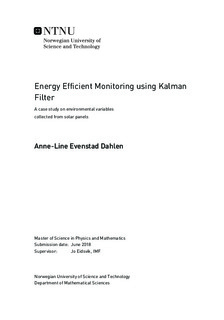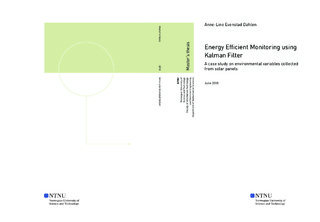| dc.description.abstract | An Internet of Things (IoT) environment uses information gathering and sharing to draw conclusions, make decisions and predict future occurrences. The technology connects devices such as mobile phones and sensors in private homes and elsewhere into a network of communication with joint operational purpose. Continuously collecting information is often infeasible due to factors such as sensor-availability, memory capacity and power efficiency. % thus restraining the communication within the IoT system.
Decision making within the IoT network is however based on accurate variable information and a reduction in the measurement frequency must be done thoughtfully. Additionally, a system with battery-powered devices that simultaneously harvest energy from the environment by e.g. solar panels can contribute with surplus energy to the IoT network. Continuous measurements would limit the accumulated energy contribution, and we therefore seek to replace the measurements by predictions, allowing greater accumulated energy surplus to be transferred.
This thesis presents solutions for making energy efficient data collection from solar panels with battery-powered sensors by applying a monitoring algorithm. Decisions within the algorithm are based on event- and self-triggering controls by looking at the value contribution at each data-collecting time step. Energy surplus is measured as the accumulated effort to avoid battery discharge, and prediction accuracy is computed as a joint probability where uncertainty increases with the consecutive number of predictions. A multivariate Seasonal Autoregressive Moving Average (SARMA) model is fitted with temperature and humidity data collected from solar panels at NTNU and transformed to a state space representation. The conversion is used to obtain predictions from a multivariate Kalman filter, which is an approach to on-line filtering and prediction problems. Because there are two objectives to be satisfied, a multicriteria constraint with weighted average on prediction accuracy and energy surplus is applied to analyse the performance. After monitoring, a trade-off between the objectives is needed, since, the result depends on the decision makers preference, which could be either to have confident data collection or high amount of accumulated energy surplus. | |

